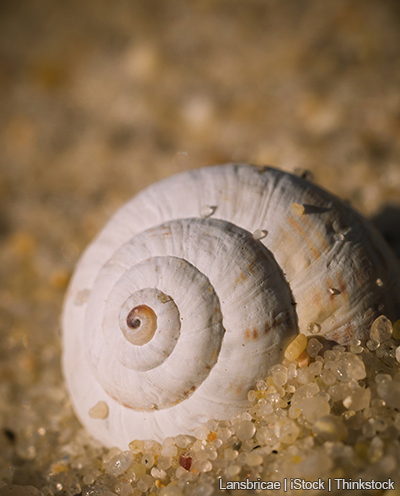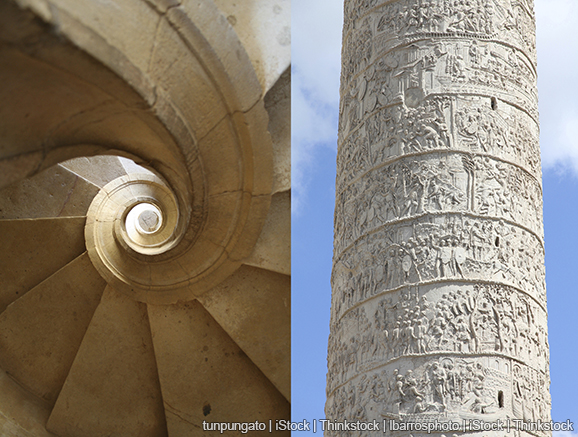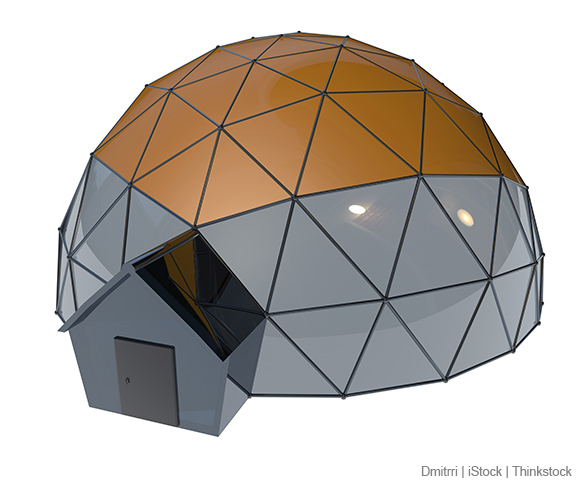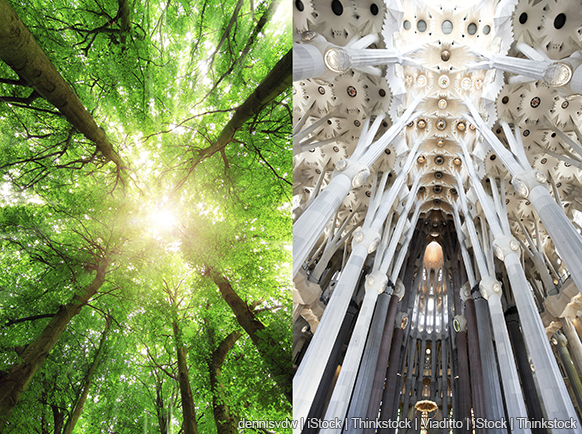Designed by Nature
1 Look around and you will start to realize how many inventions are inspired by nature. Airplanes that glide through the air use some of the same design features of a bird. Newly developed walking canes that help the visually impaired navigate obstacles use ultrasonic waves similar to echolocation: the use of sound to help direct movement, used by bats and dolphins. These are just a few examples of human innovation that use nature as a model.
2 When humans copy what they see in nature, it is called biomimicry: bios means “life” and mimesis means “to imitate.” The principle behind biomimicry is not simply to copy nature, but to look at the designs that we can see in nature and use those designs to help solve human problems.
3 One of the clearest examples of biomimicry is found in the buildings that we live and work in. Contemporary architects often turn to nature for design inspiration and problem solving. Most recently, these architects have been trying to create environmentally friendly structures that serve the needs of the population, while still aesthetically pleasing to the eye. As these contemporary architects strive to create these structures, they turn to various designs in nature to inspire them.
Spirals
4 There are many forms in nature that can inspire biomimicry. One of the most common organic designs is that of the spiral.
5 The spiral is a beautiful, universal shape: it is a curve that winds outward from a fixed point. In nature, a spiral design is prominent in animals with shells; even the horns on a ram may take a spiral shape.

Here is an example of a natural spiral design.
6 Humans have been intrigued by the spiral and have used the design in their buildings. In 113 AD, the Romans built a spiral staircase inside the narrow Trajan Column. The staircase mirrors the intricate pattern of a nautilus shell.

7 Spiral staircases are not the only designs that mimic nautilus shells. Modern parking garages and buildings use the natural beauty of the coiling spiral in their construction. The design offers a space-saving feature as well—circular stairs and ramps take up less space than traditional horizontal structures.

Example of a parking garage and a building using spiral construction
Honeycombs
8 The structure of a honeycomb is composed of several hexagonal cells. When hexagon cells are stacked on top of each other, the load or weight is evenly distributed, making the beehive a strong structure.
9 The geodesic dome, which became popular in the 1960s, uses a similar design. Geodesic dome homes were viewed as environmentally friendly; they weighed less than traditional box homes, and used less energy for heating and cooling. Using a series of six equilateral triangles, a group of architects mimicked the strong structure of a honeycomb when they designed these unique structures. The design, in addition to being artistically pleasing, keeps the building from collapsing in strong winds.

Termite Colonies
10 Termites are often called the “silent destroyers.” Silently and secretly, they devour all kinds of wood, causing structural damage to homes and furniture. Some termites, however, live in termite mounds: remarkable, above-ground structures made of mud. These mounds can be as tall as nineteen feet! Even more amazing than their incredible size is the way the mounds function.
11 The walls of a termite mound are covered with tiny holes. These holes allow air to enter and filter throughout the entire mound. The top of the mound is actually a chimney with several small tunnels. When warm air rises through the chimney, it mixes with fresh air, cools, and then sinks down into the cellar where the termites live. The tiny termites have designed a building that maintains a constant inside temperature.

This cut-away drawing represents the how the Eastgate building was designed to mimic the internal structure and ventilation system of the termite mound.
12 This intricate cooling system has been copied in an office building in Harare, Zimbabwe. Architect Mick Pearce designed the Eastgate Center using a cooling and heating system similar to the design of the termite mounds. The natural cooling system in the Eastgate Center uses ninety percent less energy than other conventionally cooled buildings of equal size.
Forest Canopy
13 Spanish architect Antoni Gaudí was inspired by a forest canopy when he designed the Sagrada Familía Basilica. Rather than using cylindrical columns, he designed columns that branched out like a tree. This tree-like design of the interior columns allowed the weight of the heavy roof to be evenly distributed. Gaudí applied a new concept in designing a building, an idea inspired by nature.

Conclusion
14 Biomimicry is not cosmetic imitation. Buildings that simply look like a fish, a shell—or some other object in nature—are not using the principles of biomimicry. If a structure truly employs the principles of biomimicry, the natural features are incorporated because their designs work with the natural environment and are efficient. Look around and see what solutions nature has to offer. You may just be inspired to design a new eco-friendly structure.